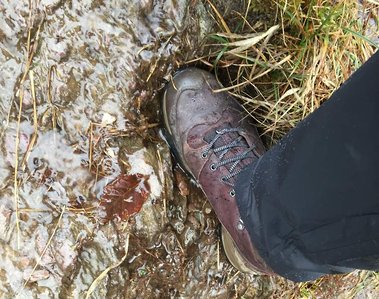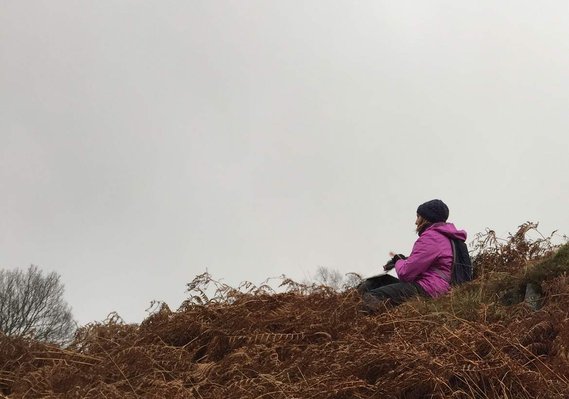Project 1: A Scenographer Walks
Outline
This is the first practical project undertaken for my PhD, at a point early in the project where the focus was different to that of autoscenography. This project focused on my experience of walking (alone) in the Lake District, as a scenographer. I carried scale model pieces and used these to stage interventions in the landscape as I walked, recording these and other embodied explorations on my camera. Following each walk I wrote reflectively about the experience of walking the fells, as a scenographer who designs performance space. This eventually became a narrative account published in Performance Research Journal (Vol 24. Issue 2) entitled Figure with Landscape: A Scenographer Walks.
Reflection
The Lake District location is not significant to the overarching exploration of autoscenography but after twenty years of collaborative theatre design practice, the independent focus on how my body moved through and interacted with space was significant. Thus, the second part of the title of the Performance Research article documenting this experience; “A scenographer walks”, represents the beginnings of autoscenography – to consider the scenographer’s own experience of space and to undertake this reflection as an individual practice that sits away from the processes of professional theatre-making.
The reflective potential of autoscenography to the practitioner is manifest in this project within the concept of ‘entfernung’ – a phenomenological experience of space framed by Heidegger and unpacked in this article in relation to the experience of looking across landscape to see places walked or yet to be walked. This offers a metaphor for considering one’s own practice - past, present, and future - and the ways in which it might evolve. In this respect A Scenographer Walks could be considered a typical first PhD project – containing the beginnings of the final thesis, while reflecting a scenographer-researcher at the threshold of a change in practice that will unfold over the course of the PhD journey.
Further commentary on the relationship of this project to the development and exploration of autoscenography will be incised between article pages, with additional images not included in the published article. Highlighted and numbered sections within the original article refer to numbered sections of commentary. As a final nod towards work made at the intersection of the scenographer’s story with her practice, it feels significant to note that this project happened shortly after the end of a long-term personal relationship, and the combining of research with a (newly) solo walking trip is partly a result of those circumstances. Referring back to two of the three qualities of autoscenography identified in Autoscenography, She Wrote, this project therefore offers space to explore the 'super-local' immediacy of the scenographer's relationship to space alongside the subtextual 'personal' dimension of walking alone.
Page 8
A Note on Sexist Walking References
Having published the Performance Research article in July 2017, I saw the tweet above from Clare Qualmann, who was attending a conference on walking art. As someone who was new to walking art practice and had learned a great deal about it subsequent to publication, I realised that I was guilty of the same sexism within my journal article. I set about putting this right through a visiting lecture called The Hills are Alive with the Sound of Scenographic Practice Research at Central School of Speech and Drama. In this lecture, I took the conference paper from which the article had stemmed and brought in references I considered to be missing, positioning Qualmann's tweet as the catalyst for this re-framing. This action was important to the exploration of autoscenography, in the light of the feminist dimension the overall project and in terms of embodying another of the three qualities of autoscenography, that of 'self-accountability' (see Autoscenography, She Wrote). Artists, writers, and practitioners cited included Cathy Turner, Louise Ann Wilson, Lizzie Philips, Simone Kenyon, Nan Shepherd, Aileen Harvey and Janet Cardiff.
Page 9
1. The article foregrounds the scenographer's participation in the 'scenography' of the landscape, with walking as an extension of scenographic practice. This is the beginning of the autobiographical dimension of the autoscenography project, where lived experience is positioned as a component of scenographic practice.
2. At the time this project was made, the focus was on being in or with space. While the landscape-based element of the PhD eventually receded, the choice to explore space outdoors reflects my being an active person and makes a connection between the particularity of this and the way in which I encounter space.
3. The familiar objects and supporting equipment of the walker are highlighted within the article - this is autobiography told through objects and photography, an approach that influenced the documentation of the overall PhD exploration and the presentation of the three projects that followed. The approach highlights autoscenography as scenographic i.e., something that happens, as opposed to the composition of a series of images.
4. On p121 there is the first mention of entfernung, from Heidegger's Being and Time (2010), which predicts the reflective dimension of autoscenography, and which remained present through subsequent projects. At the time this project unfolded, entfernung was considered mostly as a spatial experience, but came to offer a model for considering one's values and direction as a scenographer. As a phenomenon, it is notable that it shares the elements of space and time with scenography (refer to Practice Review Part 1, slide 5).
Page 10
5. The reflection that I was moving inside and outside the act of walking highlights the intimacy of this project - that I chose to focus on how I was experiencing space as an internal/embodied and visual process, rather than space being something that had (in my former practice) been an element that was manipulated at 'arm's length' through designing performance space in my studio. This is autoscenography in the sense that it brings the scenographer's physical and lived experience of their primary medium into the foreground.
6a. The early walks comprising this project featured a series of small interventions in which I aimed to become part of the landscape by placing myself into it. In this way a walk became a series of scenographies, which deployed the body of the scenographer as both material and agent. This predicted my becoming an integral part of my own scenography, or a component of scenography, which was more visible within Project 2.
6b. Moments of failure, humour, or rough humanity within the practical part of this project were present in this project as soon as I started making it. These moments contrasted with the more conventionally awestruck or poetic responses I had to the experience of being in the landscape and were just as interesting to me. This demonstrates another feature of autobiography within this research, where having a sense of humour, admitting failure or where the story of the scenographer is an acknowledged dimension of her scenography.
A Note on Being in Costume
In presenting this project as a conference paper at the Performing Mountains Symposium (University of Leeds, 2017) and later in its re-framed version within The Hills Are Alive... I wore the 'costume' of my walking practice (waterproof jacket, rucksack, and boots) to support telling the story of the project. In terms of autoscenography, this can be understood as a strategy to blend the persona of the 'presenting practitioner' with the reality of being the person who was present within the actions of practice research. It enabled me to participate within the formality of a conference setting in a way that felt congruent with the project and my identity as a scenographer-researcher and allowed me to highlight my subjectivity to the assembled audiences. This predicted an emergent interest within the overarching PhD project, in the possibility of being 'the same person' whether I was presenting at a conference, writing reflectively or in the middle of a practical project, with all the subjectivity this suggests.
Page 11
7a. In a continuation from the previous note, the inclusion of moments of struggle or absurdity (around being lost, for example) came to inform an approach to practice research within this PhD, which took comfort in admitting dead-ends, less successful experiments, or moments where emotion undercut a straightforward research aim. These are expressions of autobiography within the research of the scenographer and thus a component of her autoscenographic practice.
7b. A feature of this first project was the decision to re-purpose the traditional materials and equipment from my studio towards the purpose of telling the story of my experience in places outside the studio. The model pieces were used while walking to communicate experiences of space and place, and evidence an early desire to transform the traditional materials and approaches of my practice into materials of self-expression, or to help me disseminate these encounters to other researchers or practitioners.
Page 12
8. This series of 'facing' images taken from the places marked with an asterisk were important manifestations of the experience of reflection mixed with landscape that were articulated through the concept of entfernung. I remarked to my lead supervisor at the time that I felt these images and experiences had a relationship to research process and were significant to where I was in the development of my practice, but I was - at that time - unsure how to articulate this value.
9. With the benefit of hindsight, writing at the point of having completed four practice research projects for this PhD, I can see entfernung (or reflection across distance) as one of the most valuable benefits of autoscenographic practice - that one is afforded the opportunity to reflect on how one has formally practiced, and to anticipate what might be emerging on the horizon.
Page 13
10. One of the things that I note is missing from this early project is a specificity relating to the embodied experience referred to here - that it is specifically my body, my experience and with my particular raft of bodied privilege. The tone of the account is curiously impersonal much of the time, for a project that ultimately was to embrace the scenographer's story and autobiographical emphasis. This highlights the fact that this was an early piece of work, where I was yet to to fully embrace the personal dimension of my research.
11. However, the seeds of the future autoscenography project -foregrounding the personal experience, subjectivity and story of the scenographer and considering how this then intersects with their practice - are all present within A Scenographer Walks from the beginning. I have included this project within the thesis partly because of the value of these early findings and partly because it illustrates the arc of the PhD journey.
Project 1 sees the scenographer embedded in the activity of ‘doing’ research, as outlined in My Approach. Continuing this theme of doing - and looking ahead to the framing of autoscenography with existing forms of practice and theory – the next section is the first part of a three-part Practice Review.


















